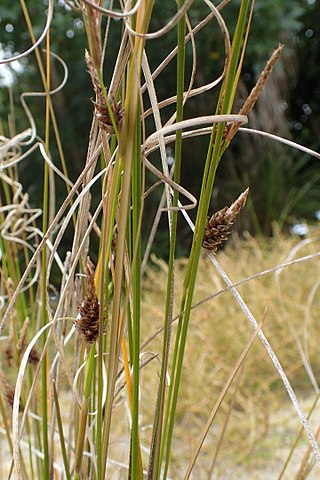
Olearia hectorii is a species of flowering plant in the daisy family Asteraceae. Its common names include deciduous tree daisy and Hector's tree daisy. It is endemic to New Zealand, where it is nationally endangered.

Pittosporum fairchildii, commonly called Fairchild's kohuhu, is a species of plant in the Pittosporaceae family. It is endemic to New Zealand. This species was first described by Thomas Frederic Cheeseman. It is named in honour of Captain J. Fairchild, a 19th-century seaman who commanded the S.S. Stella.

Pittosporum turneri, commonly called Turner's kohuhu or the tent pole tree, is a species of plant in the Pittosporaceae family. It is endemic to New Zealand. P. turneri was first described by Donald Petrie in 1925. The species flowers between the months of October to December. P. turneri is threatened by possums. It is regarded as being Nationally Vulnerable.

Carex lasiocarpa is a broadly distributed species of wetland sedge sometimes known as woollyfruit sedge or slender sedge. It is considered a species of Least Concern by the IUCN Red List due to its extensive range with many stable populations.

Carex vaginata is a species of sedge known by the common name sheathed sedge.

Carmichaelia muritai, common name coastal tree broom, is a species of plant in the family Fabaceae. It is found only in the South Island of New Zealand.

Carex lacustris, known as lake sedge, is a tufted grass-like perennial of the sedge family (Cyperaceae), native to southern Canada and the northern United States. C. lacustris us an herbaceous surface-piercing plant that grows in water up to 50 cm (1.6 ft) deep, and grows 50–150 cm (1.6–4.9 ft) tall. It grows well in marshes and swampy woods of the boreal forest, along river and lake shores, in ditches, marshes, swamps, and other wetland habitat. It grows on muck, sedge peat, wet sand or silt, in filtered or full sunlight.

Carex capillacea, common name yellowleaf sedge in Tasmania, is a species of sedge found in Assam, the far east of Russia, New Guinea, south east Australia, New Zealand, Malesia, China, Japan and India.

Carex solandri is a species of sedge that was first described by Francis Boott in 1853.

Carex berggrenii, common name Berggren's Sedge, is a species of sedge. It is endemic to New Zealand, being found on both the North and the South Islands.

Carex buchananii, common names Buchanan's sedge, cutty grass, is a species of sedge. It is endemic to New Zealand, being found on both the North and South Islands.

Carmichaelia australis, or common broom, is a species of pea in the family Fabaceae. It is native to New Zealand and found in both the North and South Islands. Its conservation status (2018) is "Not Threatened" under the New Zealand Threat Classification System.

Carex erebus is a member of the sedge family and is found on the Antarctic Islands of Australia and New Zealand.

Carex bicolor, the bicoloured sedge, is a species of sedge native to North America, Northern Europe and Northern Asia. The International Union for Conservation of Nature has assessed the plant's conservation status as being of least concern because it has a widespread distribution and faces no particular threats.

Carex hostiana, the tawny sedge, is a species of flowering plant in the genus Carex, native to Europe and northeast Canada, and extinct in Massachusetts. It is a member of the Carex flava species complex.

Carex virgata, the swamp sedge, is a species of flowering plant in the family Cyperaceae. It is native to Tasmania, New Zealand, and the Chatham Islands, and has been introduced to Great Britain. It is used in constructed wetlands for wastewater treatment.

Carex trifida, the mutton-bird sedge, is a species of flowering plant in the family Cyperaceae, native to Macquarie Island of Australia, the South Island, the Antipodes Islands, and the Chatham Islands of New Zealand, southern Chile, and the Falkland Islands. There are a number of cultivars, including 'Rekohu Sunrise', 'Glauca', and 'Chatham Blue'.

Carex ventosa, also known as Chatham Islands forest sedge, is a tussock-forming species of perennial sedge in the family Cyperaceae. It is native to the Chatham Islands.

Carex lessoniana, also commonly known as rautahi or cutty grass, is a tussock-forming species of perennial sedge in the family Cyperaceae. It is native to parts of New Zealand.

Carex litorosa, commonly known as sea sedge, is a tussock-forming species of perennial sedge in the family Cyperaceae. It is native to New Zealand.






















